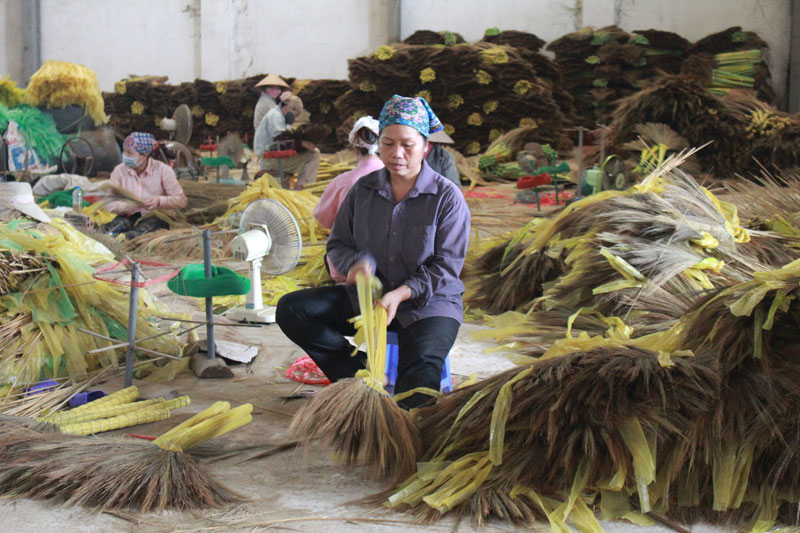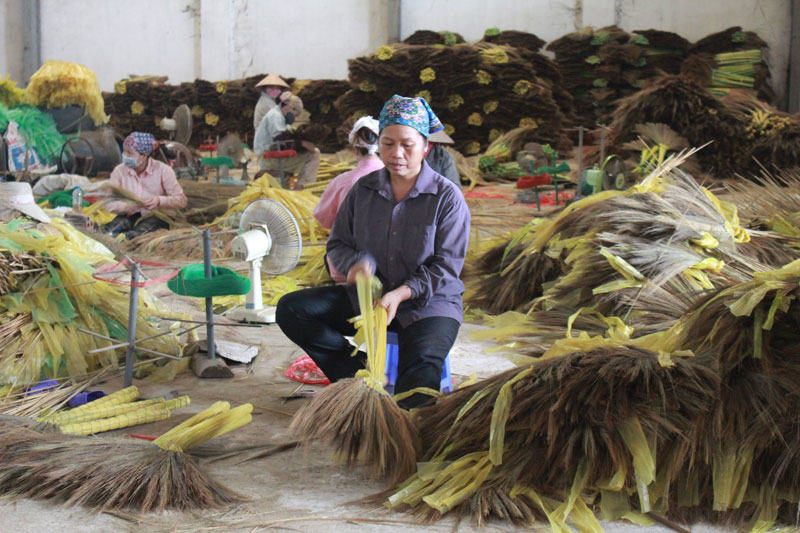
(HBO) – The working age population in rural areas in Hoa Binh account for 80 percent of the province’s workforce. Therefore, creating jobs for them is very important to socio-economic development in rural areas. Over the years, the province has given great attention to job generation for rural labourers, thus contributing to ensuring social security.
The employment rate is the 12th criterion among
the 19 criteria of new-style rural areas. A commune will complete
the criterion when the employment rate among the local working age population is at least 90 percent.

Labourers in Trung
Minh commune of Hoa Binh city receive training in Chit broom making, helping
them have stable jobs and income.
Each year, specific measures have been applied to create
jobs for labourers in localities across the province, including supporting the
creation of jobs or self-employment through the National Fund For Employment,
assisting labourers in seeking jobs abroad, and providing labourers, especially
women and the disabled, with employment consultations.
Besides, the authorities invited enterprises in and outside
the province to come to localities to give consultations and recruit workers.
At the same time, investment projects in the province have
also created tens of thousands of jobs, raising the total number of labourers
working in enterprises and other production and business facilities to about
60,000.
In the 2010-2019 period, the province has created jobs for
more than 177,000 labourers, or an average of 16,000 each year, of whom 4,000
have been sent to work abroad. The ratio of unemployment in urban areas is
under 3 percent.
So far, 191 out of all 191 communes across the province have
reached the criterion in employment.
In 2020 and beyond, the province aims to make breakthroughs
in vocational training quality towards meeting national and ASEAN standards, with
the goal of training skilled workers in production, business and services who
must also have good professional ethics, meeting the demand of both the domestic
and foreign labour markets./.
The emulation movement "Hoa Binh joining hands to build new-style rural areas” has been widely spreading, becoming a driving force that motivates the localities to renew rural landscapes and improve the material and spiritual lives of the residents. In this movement, the people play a central role-both as the main implementers and direct beneficiaries of its outcomes.
In response to the global digital revolution, Hoa Binh Newspaper is transforming itself into a modern and multi-platform media hub, blending cutting-edge technology with a restructured newsroom and a new generation of tech-savvy journalists.
Hoa Binh province’s Association of the Elderly recently held a conference to review the project on expanding the inter-generation self-help club model until 2025.
In a move to implement Resolution No. 57-NQ/TW, issued on December 22, 2024 by the Politburo, which targets breakthroughs in science-technology development, innovation, and digital transformation, the Hoa Binh provincial Department of Health has issued a plan to roll out the "Digital Literacy for All” campaign within the local health sector.
An Nghia Commune (Lạc Sơn District) is one of the communes that achieved the tha standard of the national new rural area in 2018. Entering a new development phase, the commune is now trying to meet the criteria for the advanced new rural development. With the strong political will and the public consensus, the commune is gradually overcoming the challenges to reach this goal, aiming for the sustainable development.



